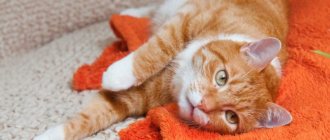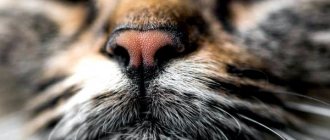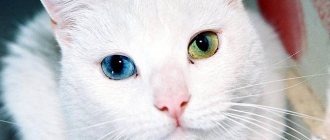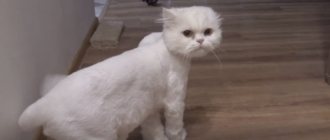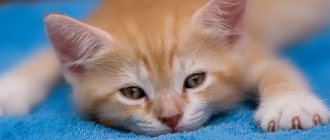Have you noticed that your cat suddenly stops walking? Are you wondering about common reasons that may explain why your cat can't walk or why your cat is struggling to walk? Although the causes of this difficulty are not always serious, it is usually necessary to contact your veterinarian to determine appropriate treatment. This treatment can only be prescribed after you have discovered the cause that is preventing cats from moving normally.
Sometimes surgery may be necessary for recovery, hence the importance of consulting a veterinarian. So, if your cat walks strangely or can't walk at all, don't hesitate to contact a professional. To learn more about “why my cat can’t walk,” keep reading the article.
The cat cannot walk on its hind legs
Before we begin to explain the reasons why a cat cannot walk or stand, we need to pay attention to the characteristics of this obstacle. A cat may develop paralysis if it stops walking altogether. This is a problem that is more common in the hind legs, which completely prevents them from moving. Therefore, your cat will not be able to walk or stand.
Are your cat's back legs giving out? In other cases, a cat cannot walk because its paws don't work, most often the cat's back paws. In these cases the weakness is obvious. You may notice that your cat is standing but falling or unable to move at all. Sometimes this is successful, but with strange movements, such as abnormal leg lifting or your cat moving its paws in circles. In other cases, difficulty with mobility occurs because the cat is suffering from tremors, tics, or convulsions throughout the body.
© shutterstock
How many days after birth do kittens begin to walk normally?
Cats' paws not only help them move, but also help the animal feel. The forelimbs lack a solid connection to the skeleton - they are connected by strong tendons. It is thanks to this feature that the cat is able to land smoothly when jumping from a great height, and also walk almost silently.
Walking skills are developed in stages. A newborn fluffy is helpless; not only can he not walk, but at this age he is also deaf and blind. At this age, only their sense of smell is developed - with its help, kittens move where they need to, crawling on their tummy. After five to ten days, the ability to navigate becomes better and the kids quickly find the cat by smell, actively working with their paws - at this time, intensive development of the hind legs occurs.
After two weeks, they gain the ability to rise and stand on all four limbs, repeating the steps after the cat. The first attempts at walking are still very uncertain - the little cats stand on their paws and, swaying awkwardly, fall on their side. During this period, joints and muscles are trained.
At three weeks, the paws develop to such an extent that small pets begin to move more or less confidently, try to run and even make their first attempts at jumping. At one month of age, their movements become complete and confident - at this age, fun games with each other, running and jumping often occur.
Paralysis in cats
Causes of paralysis in cats may include an accident, a blow, a dog attack, or a steep fall. This occurs when there is damage to the spinal column, affecting the connection between the nervous system and the legs. This can cause your cat's legs to become immobile. These injuries can also cause more serious injuries, so if you notice that your cat is struggling to walk, immediate veterinary consultation is necessary. Be sure to handle your cat carefully to avoid aggravating the injury.
Typically, when it comes to paralysis due to injury, your cat will try to move as if it were uninjured by dragging its paws. Does your cat drag its back or front paws?
X-rays can give us information about the condition of a cat's spine. Treatment will depend on the damage. Medication, rehabilitation, or surgery may be required. A cat suffering from paralysis may recover or have permanent effects, depending on the specifics of the case.
To prevent paralysis in cats, make sure your cat avoids open windows and outside hazards. You can put mosquito nets on the windows to prevent the cat from falling.
Hypertrophic cardiomyopathy in cats
Hypertrophic cardiomyopathy can also cause paralysis of a cat's legs, especially the hind legs and tail. Hypertrophic cardiomyopathy in cats occurs when the cat's cardiovascular system does not work well and blood flow is reduced.
The cat can't walk straight
There are many reasons why a cat does not walk. In older cats, you may notice that they stop climbing to heights. This is often a sign of pain, often caused by a degenerative process such as osteoarthritis.
Cats that have previously or are currently recovering from diseases such as feline panleukopenia (feline parvovirus) may also suffer from neurological complications that affect their walking. These cats will have difficulty walking straight and lifting their legs correctly. Does your cat lose balance easily? Does your cat lack coordination? This could be the reason. Such damage may be permanent, but it does not prevent your cat from leading a normal life.
Vestibular syndrome in cats
Feline vestibular syndrome is a neurological disease in cats that causes symptoms such as:
- Head tilt
- Walking in circles
- Nystagmus (constant eye movements)
- Strabismus
- Ataxia in cats, which causes incoordination that makes walking difficult.
This syndrome can be caused by: trauma, otitis in cats, infectious diseases, etc. A neurological examination is required to determine the root cause. Vestibular syndrome in cats is treatable, but some cats may be left with a bowed head as a permanent injury.
The cat behaves withdrawn and moves little
Inactivity may indicate the presence of a disease.
However, it happens that a cat that was still active yesterday suddenly stops playing, eats reluctantly, constantly lies down and shows no interest in its surroundings. This state of affairs may indicate the presence of an illness , a delayed reaction to some kind of stress, injury or bruise.
Causes
When depressed, a cat will behave withdrawn.
Such causes may be the following diseases:
- anemia;
- chronic gastritis;
- herpes virus;
- immunodeficiency virus;
- leukemia;
- hypertrophic cardiomyopathy;
- reaction to medications;
- depression;
- arterial hypertension;
- hypocalcemia.
Many of the listed pathologies are characterized by an asymptomatic course in the initial stages, so careful observation and timely examination by a veterinarian are mandatory.
Chronic gastritis
Poor quality food can cause the development of gastritis.
Inflammation of the gastric mucosa occurs in acute and chronic forms . The main reasons for the development of the disease are:
- feeding disorder – low quality feed, unbalanced diet, menu change;
- overfeeding;
- food that is too cold or too hot;
- helminthic infection;
- presence of hairballs in the stomach;
- allergy;
- stress;
- bacterial infections;
- drug overdose;
- use of toxic substances.
The development of pancreatitis is also a provoking factor.
Symptoms and treatment
The chronic form of gastritis is sluggish, almost asymptomatic.
- The animal has a decreased appetite, loss of activity, and lies down most of the time.
- Then comes relief, which will soon be replaced by exacerbation again.
- Additional “inactive” signs include a white coating on the tongue, a rumbling stomach, dull fur and pale mucous membranes.
In the chronic form of gastritis, the cat's appetite decreases and activity is lost.
Treatment
Treatment is prescribed according to the level of acidity.
For high acidity levels, Almagel is used.
- At high levels, enveloping agents are used in the form of almagel and phosphalugel.
- Antibiotic therapy is prescribed.
- Herbal infusions of licorice root and flaxseed are recommended.
- Anti-inflammatory medicinal plants – St. John's wort, chamomile.
- Dietary feeding, gentle regimen is used.
Anemia
The disease is characterized by a decrease in the level of hemoglobin and red blood cells in the blood.
The level of hemoglobin in the blood decreases with anemia.
Factors of occurrence: failure of hematopoietic processes, impaired blood destruction, imbalance in the level of hematopoiesis and blood cell destruction, genetic disorders.
Symptoms
Anemia causes a cat's heart rate to increase.
- Visible mucous membranes are bluish in color, rapid heartbeat.
- Shortness of breath, depression of the animal, and apathy appear.
- Reduced activity and appetite.
- If the process of development of pathology is prolonged, digestive system disorders begin - diarrhea or vomiting.
- For children, the disease is fraught with delays in growth and development.
Therapy
Help is directed towards eliminating the causes of the disease.
- If anemia develops due to intoxication, intravenous infusions of glucose and sodium chloride or blood transfusions are prescribed.
- Replacement treatment is used, which is aimed at replenishing the level of hemoglobin and red blood cells.
- Use preparations of iron, copper, cobalt.
- Vitamin therapy of group B is recommended.
If anemia occurs after intoxication, intravenous infusions of glucose are prescribed.
Hypertrophic cardiomyopathy
The most common disease in cats, which is characterized by thickening of the heart wall, causing the heart to increase in overall volume.
Hypertrophic cardiomyopathy is characterized by thickening of the heart wall.
The main causes are: hyperthyroidism, arterial hypertension, acromegaly - increased production of growth hormone. But also factors include: bull's heart anomaly, the presence of lymphoma, heredity .
Clinical signs
Unfortunately, it is very difficult to detect the development of pathology due to its almost asymptomatic course. The only sign may be decreased activity and apathy of the pet. The pathological process is distinguished by clinical examination. Auscultation will reveal heart murmurs and a galloping beat. Heart rate failure.
A sign of hypertrophic cardiomyopathy may be decreased activity.
Help methods
A treatment regimen for hypertrophic cardiomyopathy has been developed.
- This regimen includes beta blockers - atenolol, propranolol, calcium channel blockers - diltiazem.
- ACE inhibitors – ramipril, enalapril.
- ARBs inhibitors – telmisartan.
Atenolol is a beta blocker for hypertrophic cardiomyopathy.
The outcome of the disease and recovery will depend on the timeliness of the therapy started.
Hypocalcemia
A disease in which the level of calcium in the blood serum is below the physiological norm. A decrease in this level occurs in the presence of the following pathologies: hypoparathyroidism, vitamin D hypovitaminosis, chronic renal failure, cirrhosis, pancreatitis, osteomalacia, pathological processes in the small intestine.
With hypocalcemia, the level of calcium in the blood is lower than normal.
Signs
The main manifestations of the disease are associated with impaired nervous and muscle activity.
- The cat shows anxiety, which is replaced by loss of strength, lethargy, and drowsiness.
- Possible nervous twitching of the antennae, constant rubbing of the limbs of the face, muscle tremors.
- The pet rarely gets up from its bed, and if it does, it walks with a heavy gait.
- It seems that the limbs are made of wood.
- Possible rapid breathing, decreased or complete lack of appetite, feverish conditions.
- In the severe stage, convulsions appear.
Hypocalcemia is accompanied by drowsiness in the cat.
Treatment principle
An important aspect is determining the cause.
- Next, intravenous administration of calcium gluconate is carried out.
- If a renal cause is observed, a special diet and phosphate-binding drugs are prescribed.
- The provoking factor associated with poisoning is eliminated by gastric lavage, administration of sodium bicarbonate and ethanol.
- Pancreatitis is treated with painkillers and antibiotics. Anti-inflammatory medications.
- Blood transfusions are performed, and surgical removal is less common.
- It is advisable to give calcium gluconate in tablets and vitamin D supplements.
To determine the correct treatment, the cause must first be identified.
The cat cannot walk and does not eat: poisoning
Sometimes cats cannot walk because they have lost control of their body. Are you wondering why your cat doesn't walk and keeps falling? This loss of body control in cats may result from or be caused by seizures, tremors, or tics, sometimes accompanied by other symptoms. These cases are often caused by poisoning, which requires immediate veterinary attention. The prognosis in these cases depends on: the substance that was ingested, the time and age, breed and health of the cat.
To avoid poisoning, seizures or tremors, you must make sure your cat is safe at all times. Be sure to prevent access to potentially toxic substances or plants. Particular care should be taken when it comes to antiparasitic products for dogs, as they sometimes contain active ingredients that are toxic to cats. If you know what substance caused the cat's poisoning, be sure to inform your veterinarian. With fluid therapy and medications, your cat can make a full recovery, although this depends on the prognosis.
© shutterstock
The cat does not walk on his front paw: injury to the paw pad
Have you noticed that your cat is walking strangely? Sometimes cats have difficulty walking due to injuries. So if you suspect any localized damage to your cat's paws, be sure to carefully examine her toes, nails, and paw pads. If you notice an injury, contact your veterinarian.
To avoid injury to your cat's paws, make sure your cat does not walk on hot surfaces. Also, make sure your cat's nails are always in good condition. Additionally, we recommend establishing a routine where you check your cat's paws and nails regularly.
A cat cannot walk on one hind leg: other reasons
If your cat's articulated legs are failing and none of the previous causes fit your cat's individual case, there are other pathologies that carry this condition as a symptom. Have you noticed that your cat can't walk or stand? Other causes of sudden paralysis of the hind legs of cats include:
- Constipation
- Thrombosis
- Herniated disc
- Hip dysplasia
- Diabetes
- Cerebellar hypoplasia
- Saddle thrombus (blood clots in cats)
- Tick paralysis
In all of these cases, veterinary intervention is necessary. If your cat is struggling to walk and is not receiving professional medical attention, your cat's life may be seriously at risk.
Cat care
If your cat has a tendency to fall over sometimes, there are some important things you need to keep in mind. Make sure you keep them away from the stairs in your home to avoid a serious accident. You can buy gates from your local pet store to block off the stairs.
Those who have acquired a cat from a shelter will want to know the medical history. This will help you understand what conditions your kitten may be in. This will make it easier to understand why they keep falling.
When you take your cat to the vet, he or she will likely want to run several tests, including x-rays and blood work. This will help narrow down the possible reasons for this behavior.
It is definitely possible that you can reduce or eliminate this behavior in your cat through medication or surgery. Keep in mind that your cat's prognosis depends entirely on what caused her to fall.
The kitten doesn't walk
Have you noticed that your kitten can't walk or stand? In addition to the above-mentioned syndromes, when it comes to kittens, we must analyze the possibility of fading kitten syndrome.
Kittens, especially those under 8 weeks of age, are very fragile and susceptible to disease. If your kitten suddenly cannot walk, is lethargic and unresponsive, immediate veterinary attention is required!
Fading kitten syndrome: symptoms
- Labored breathing
- Problems walking or standing
- Lethargy
- Excessive crying
- Pale or white gums
- Low body temperature
Fading kitten syndrome: causes
- Insufficient care and attention
- Injury
- Hypothermia
- Bacterial infection
- Viral infections: herpes virus, feline AIDS, etc.
- Poorly developed immunity
Fading kitten syndrome: treatment
If your kitten is not walking, is very cold, or is showing any other signs of the symptoms above: Take him to the vet IMMEDIATELY. Also, make sure the kitten is warm, has enough water, and is offered an adequate, high-quality diet.
How to help and how to care for a kitten in the first month
A responsible owner should be aware of the difficulties kittens may have when they begin to make their first attempts at walking on their own. Throughout the process, they may encounter a lot of dangers. Therefore, you need to take care of safety and comply with certain requirements. It is necessary to remove objects that can injure the kitten and pose a potential danger - flower pots, chairs, small and sharp objects, household chemicals. You need to carefully control the child who is playing out and not allow him to jump onto a high surface, as this can cause harm to his still weak legs. In a word, it is recommended to remove everything from the eyes that might interest a curious furry, tie up the curtains, lay a carpet on the sliding floor covering and take other measures. This way you can protect your pet from dislocation.
No less important than adapting the cat’s movement routes to its needs is to prohibit picking up the kitten - especially for small children, who can accidentally injure the pet. It is imperative to explain to the child in detail that this is dangerous and the animal may be hurt. When the fluffy one grows up, you need to teach children to pick it up and hold it correctly. It is important for all household members to move around the apartment very carefully, since the kitten can end up anywhere and there is always a risk of stepping on its paw. Traveling by transport during this age period is also extremely undesirable. If your fur baby requires a veterinary examination, it is better to invite a doctor home, as a visit to the clinic may pose a risk of contracting an infection.
An old cat cannot walk: reasons
Have you noticed that your old cat can't walk or stand? Cats between 7 and 8 years of age become prone to diseases such as arthritis. Feline arthritis is very common in older cats, so it should not be ignored as a possible reason why your older cat is not walking. Other reasons older cats may not be able to walk include:
- Diabetes: nerve degeneration
- Hyperthyroidosis
- Kidney disease
- Blindness
If your older cat is unable to walk or stand, take her to the vet IMMEDIATELY. A professional will be able to properly diagnose the problem and treat accordingly.
Sources : https://europepmc.org/abstract/med/4055520 https://www.physiology.org/doi/abs/10.1152/ajplegacy.1943.139.5.667?journalCode=ajplegacy
Serious reasons why a cat is lethargic
However, the lethargy of a pet should not be taken lightly: it happens that a cat is lethargic due to illness:
- Stress
. If the cat has become lethargic, it may be due to a mental disorder, which can occur in pets for various reasons, for example, when moving to a new home, changing owners, having a new pet in the house, or suddenly switching to new food. The main signs of stress in cats include lethargy (although in some cases the pet may look very agitated), refusal to eat or literally gorging, constant licking of fur (even to the point of bald spots), bad behavior (the cat marks and shits outside the tray, screams loudly, gnaws flowers, destroys furniture, etc.). As a rule, stress goes away on its own if you regularly communicate and play with the cat, but in some cases it is necessary to take sedatives; - Poisoning
. If the cat has become lethargic, trembles, breathes loudly and heavily, refuses to eat, has vomiting and/or diarrhea, saliva runs heavily, the mucous membranes have turned red or blue, the temperature has risen or dropped (normal temperature in adult cats is from 37.5 up to 39 degrees, for kittens - from 39 to 39.5 degrees), there is a suspicion that the animal has been seriously poisoned by something. What can cause poisoning in pets? Anything: rotten fish, houseplant juice, washing powder, rodent poison and much more; - Jumps in blood pressure
(very difficult to diagnose!). There is a possibility that the cat is lethargic all the time if she has low or high blood pressure, which normally ranges from 105/65 to 135/95 mmHg. Signs of high blood pressure include apathy, red eyes, dilated pupils, blurred vision (this can be calculated by observing an animal that will bump into walls or furniture when walking), noises during breathing, swelling of the extremities, vomiting, nosebleeds, high pulse (more than 180 beats per minute). Low blood pressure can be recognized by constant drowsiness, loss of appetite due to nausea, decreased heart rate (below 80 beats per minute), and loss of consciousness. If your pet has such symptoms, you need to quickly go to the veterinarian; - Endocrine disorders
. In some situations, a cat is lethargic due to diabetes mellitus or Cushing's syndrome. Plus, don’t forget about hormonal imbalance, which often occurs in pets after giving birth, and even after sterilization, a lethargic cat is common. You can figure out from the following symptoms that your pet has endocrine problems: extreme thirst, frequent urination, changes in appetite (the cat either begins to eat very little or constantly asks to be fed), deterioration in the condition of the coat and skin, an increase in the volume of the abdomen, weight fluctuations, cramps, heaviness of gait, blurred vision, low motor activity as a result of weakening muscles; - Diseases of the musculoskeletal system
, for example, osteochondrosis, arthritis, joint dysplasia, bone fractures, joint dislocations, ligament rupture. Find out that a cat has problems of this nature simply by the following symptoms: lameness, refusal to jump, change in gait, pain (the cat growls and bites if the owner touches the sore spot), swelling in the area of the affected joints, refusal to eat and apathy. Cats with diseases of the locomotor system often do not sharpen their claws, take poor care of their coats, and do not wash themselves; - Oncology
. If the cat is lethargic, lies down most of the day, eats very little or refuses food at all, is rapidly losing weight and meows pitifully, suffers from vomiting, diarrhea and internal bleeding, the development of cancer can be suspected. Other signs of cancer in cats include bad breath, the appearance of ulcers and minor swelling on the body (in some cases the tumor is visible to the naked eye), aimless wandering around the apartment; - Infectious diseases
. A cat is usually very lethargic with the following infectious diseases: calcivirosis, rhinotracheitis, leptospirosis, panleukopenia, immunodeficiency virus. Common signs of these illnesses include a rise in body temperature, refusal to eat, shortness of breath, cough, wheezing during breathing, vomiting and diarrhea (usually foul-smelling and greenish), changes in the color of mucous membranes, discharge from the nose and eyes; - Parasites internal and external
. We are talking about the most common uninvited guests - worms, ticks and fleas. Helminthic infestations are recognized by stool disorders (a cat may have diarrhea alternating with constipation), vomiting, weight loss, an increase in abdominal volume, flatulence and rumbling in the abdomen, bad breath, greenish discharge from the eyes. Ear mites can be identified by constant shaking of the head, the appearance of a large amount of dark sticky wax, and itching (the animal constantly scratches its ears). Ticks on the body provoke the appearance of wounds and scales on the skin, hair loss to the point of baldness, and constant itching. Other parasites, fleas, manifest themselves in much the same way. Many owners fight worms with deworming agents, and use insectoacaricides to eliminate skin parasites, but before using such products it is better to consult a specialist; - Inflammatory diseases of internal organs
. Almost any inflammation is guaranteed to cause apathy in the cat and a refusal to play. So, a cat can be sad, for example, with gastritis or colitis, pancreatitis, cholecystitis, pyelonephritis, stomatitis, myocarditis. There are plenty of inflammatory diseases, so it’s difficult to name general symptoms. With inflammatory diseases of the gastrointestinal tract in animals, stool disorders and vomiting, bloating, flatulence, blood in the stool, and fever are observed. If there are problems with the urinary system, the cat is lethargic and does not eat for several days or eats but little, there will probably be thirst and pain during urination. If the heart is affected, the pulse will rise above normal and shortness of breath will appear. And if the cat’s mouth is inflamed, the cat will salivate heavily, the gums will become red and swollen, and the appetite will decrease or disappear; - Hypovitaminosis
. Lethargy can also be caused by a lack of vitamins, for example, with a poor, monotonous diet. Animals with this problem are often inferior in height to their counterparts, they have dull hair and poor skin condition (dermatitis, dandruff), females often have miscarriages, and have problems with bowel movements; - Anemia
. If the production of hemoglobin and red blood cells is disrupted, almost all purrs experience weakness, cyanosis of the mucous membranes, shortness of breath, a drop in blood pressure, pulse fluctuations, and deterioration in the quality of the coat; - Dehydration
. With a lack of water in the body, the cat is lethargic and the nose is dry, the skin loses elasticity, the eyeballs look sunken, the mucous membranes dry out, saliva becomes sticky and viscous, and the pads of the fingers are cold to the touch. A cat in this state does not eat and hardly drinks, although it desperately needs water. If the animal cannot be given water even by force, you should immediately contact the clinic, where the doctor will prescribe an infusion of electrolyte solutions subcutaneously or intravenously; - Foreign body in the pharynx or elsewhere in the gastrointestinal tract
. If the cat is lethargic and does not drink, and also refuses to eat, it often vomits and salivates profusely, its voice becomes hoarse, there is a possibility that something is stuck in the throat or elsewhere in the gastrointestinal tract, for example, a fish bone or small part from a toy; - Various complications after surgery
(suppuration or suture dehiscence, postoperative hernia, etc.). If the cat appears lethargic after surgery during the first 1-3 days, then there is nothing to worry about, provided that the animal drinks water and shows at least minimal interest in food. Fever, plaintive meowing, blood or pus from a postoperative wound, constipation, vomiting are reasons to immediately contact the clinic.




